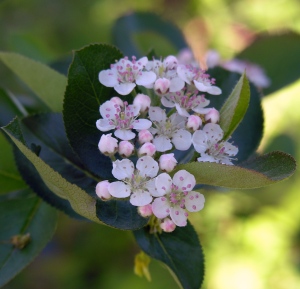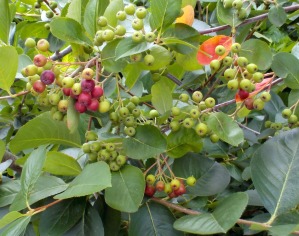Aronia is a genus of native shrubs that includes two familiar species (or species that should be familiar, because they’re gorgeous, wildlife friendly, and carefree): Aronia melanocarpa (black chokeberry) and Aronia arbutifolia (red chokeberry). The common names refer to the color of the fruit of the respective species. I grow both. Red chokeberry is perhaps a little more demanding in terms of site–it does best in full sun. Black chokeberry does well as long as it gets at least a couple of hours of sun, although the more sun, the more fruit. Both species are considered to be wetland plants, although both do just fine on my very dry site.
Aronia is a member of the rose family (Rosaceae), as are so many of our most ornamental plants. You can see it in the simple, five-petaled flowers, which are small but lovely and lend grace to the early spring garden:
You can also see it in the fruits, which look like tiny (1/4″) apples. Right now they are just beginning to show color; in a few weeks they will be midnight black:
The orange leaves give a preview of the lovely fall color. As the photo shows, many shrubs lose some lower leaves when their fruit ripens–the plant is putting so much energy into seed production that it must sacrifice a few leaves. Those leaves usually turn the color of fall.
Aronia berries are the latest superfood, full of antioxidants and other good stuff. They have been popular in Europe as a health food for some time, and the news is beginning to reach the U.S. media. As a result, growers are starting to produce the fruits commercially; cooperative extensions are putting out information for growers, and growers’ associations are being formed.
I originally planted aronia, as I do most shrubs, for the birds, and the birds do like the fruits. The fruits are edible to humans, although don’t eat them raw–the plant’s common name, “chokeberry,” describes the extremely astringent taste. To use the fruits, you need to cook them, preferably along with other fruits that provide some sweetness. Like crabapples, aronia berries have lots of natural pectin, so they lend themselves to jam making. Last season I made a delicious jam out of aronia berries, plums, and peaches.
Plant an aronia, or two or three. They’re lovely, easy to care for, environmentally friendly, and well-behaved. The health benefits are just icing on the cake.

